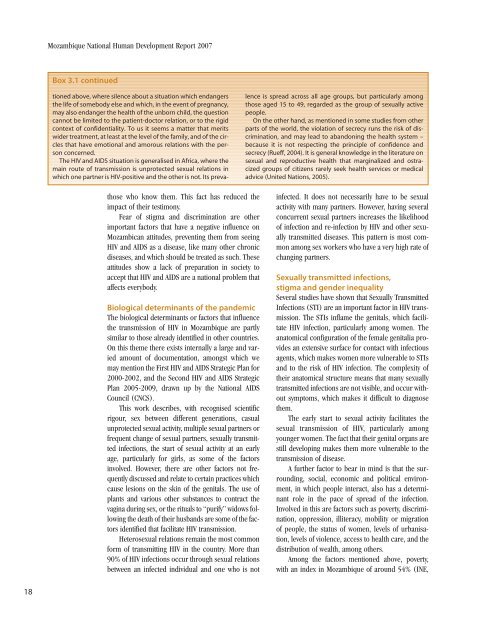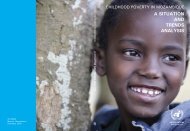English language version - Human Development Reports - United ...
English language version - Human Development Reports - United ...
English language version - Human Development Reports - United ...
- No tags were found...
Create successful ePaper yourself
Turn your PDF publications into a flip-book with our unique Google optimized e-Paper software.
Mozambique National <strong>Human</strong> <strong>Development</strong> Report 2007Box 3.1 continuedtioned above, where silence about a situation which endangersthe life of somebody else and which, in the event of pregnancy,may also endanger the health of the unborn child, the questioncannot be limited to the patient-doctor relation, or to the rigidcontext of confidentiality. To us it seems a matter that meritswider treatment, at least at the level of the family, and of the circlesthat have emotional and amorous relations with the personconcerned.The HIV and AIDS situation is generalised in Africa, where themain route of transmission is unprotected sexual relations inwhich one partner is HIV-positive and the other is not. Its prevalenceis spread across all age groups, but particularly amongthose aged 15 to 49, regarded as the group of sexually activepeople.On the other hand, as mentioned in some studies from otherparts of the world, the violation of secrecy runs the risk of discrimination,and may lead to abandoning the health system –because it is not respecting the principle of confidence andsecrecy (Rueff, 2004). It is general knowledge in the literature onsexual and reproductive health that marginalized and ostracizedgroups of citizens rarely seek health services or medicaladvice (<strong>United</strong> Nations, 2005).those who know them. This fact has reduced theimpact of their testimony.Fear of stigma and discrimination are otherimportant factors that have a negative influence onMozambican attitudes, preventing them from seeingHIV and AIDS as a disease, like many other chronicdiseases, and which should be treated as such. Theseattitudes show a lack of preparation in society toaccept that HIV and AIDS are a national problem thataffects everybody.Biological determinants of the pandemicThe biological determinants or factors that influencethe transmission of HIV in Mozambique are partlysimilar to those already identified in other countries.On this theme there exists internally a large and variedamount of documentation, amongst which wemay mention the First HIV and AIDS Strategic Plan for2000-2002, and the Second HIV and AIDS StrategicPlan 2005-2009, drawn up by the National AIDSCouncil (CNCS).This work describes, with recognised scientificrigour, sex between different generations, casualunprotected sexual activity, multiple sexual partners orfrequent change of sexual partners, sexually transmittedinfections, the start of sexual activity at an earlyage, particularly for girls, as some of the factorsinvolved. However, there are other factors not frequentlydiscussed and relate to certain practices whichcause lesions on the skin of the genitals. The use ofplants and various other substances to contract thevagina during sex, or the rituals to “purify” widows followingthe death of their husbands are some of the factorsidentified that facilitate HIV transmission.Heterosexual relations remain the most commonform of transmitting HIV in the country. More than90% of HIV infections occur through sexual relationsbetween an infected individual and one who is notinfected. It does not necessarily have to be sexualactivity with many partners. However, having severalconcurrent sexual partners increases the likelihoodof infection and re-infection by HIV and other sexuallytransmitted diseases. This pattern is most commonamong sex workers who have a very high rate ofchanging partners.Sexually transmitted infections,stigma and gender inequalitySeveral studies have shown that Sexually TransmittedInfections (STI) are an important factor in HIV transmission.The STIs inflame the genitals, which facilitateHIV infection, particularly among women. Theanatomical configuration of the female genitalia providesan extensive surface for contact with infectiousagents, which makes women more vulnerable to STIsand to the risk of HIV infection. The complexity oftheir anatomical structure means that many sexuallytransmitted infections are not visible, and occur withoutsymptoms, which makes it difficult to diagnosethem.The early start to sexual activity facilitates thesexual transmission of HIV, particularly amongyounger women. The fact that their genital organs arestill developing makes them more vulnerable to thetransmission of disease.A further factor to bear in mind is that the surrounding,social, economic and political environment,in which people interact, also has a determinantrole in the pace of spread of the infection.Involved in this are factors such as poverty, discrimination,oppression, illiteracy, mobility or migrationof people, the status of women, levels of urbanisation,levels of violence, access to health care, and thedistribution of wealth, among others.Among the factors mentioned above, poverty,with an index in Mozambique of around 54% (INE,18
















